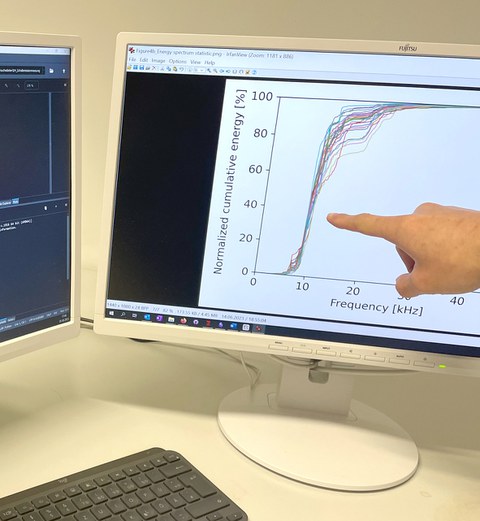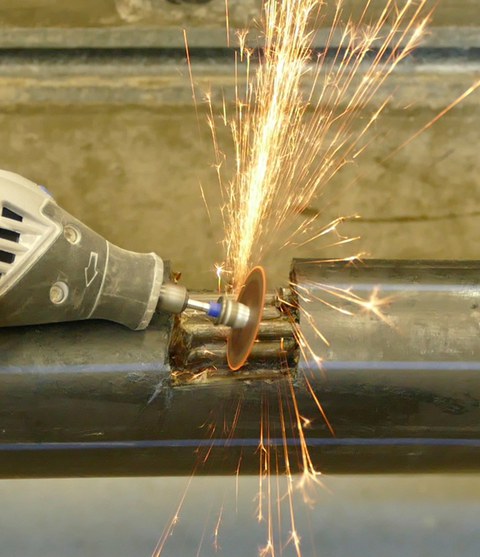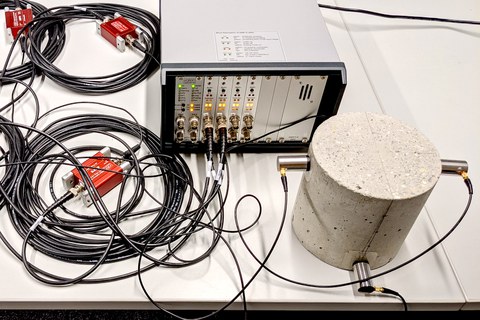Schallemission zur Schadenserkennung
Inhaltsverzeichnis
Projektdaten
|
Titel | Title |
Bericht aus dem Jahrbuch 2023
Energiespektralanalyse von Drahtbrüchen in Spanngliedern

Auswertung der Energieverteilung der 30 Spanndrahtbrüche eines Spannglieds
Die Verwendung von Hybridtürmen für Onshore-Windenergieanlagen hat in den letzten Jahren an Popularität gewonnen. Die Türme bestehen aus einen Spannbetonturm, auf dem ein Stahlturm aufgesetzt wird. Diese modulare Bauweise ist kosteneffizient und bietet Vorteile bei Transport und Montage.
Der Betonturm besteht aus vorgefertigten Segmenten und wird extern vorgespannt. Die Aufrechterhaltung des ordnungsgemäßen Zustands der Spannglieder ist entscheidend für die Sicherheit und Leistungsfähigkeit des Turms. Um die Charakteristika möglicher Drahtbrüche zu untersuchen, wurden Versuche an vorgespannten Spanngliedern mit ähnlichen Randbedingungen wie bei realen Windenergieanlagen durchgeführt. Vier Spannglieder des Typs SUSPA EX30 mit jeweils 30 parallelen Drähten wurden in einem Prüfstand von 12 m × 4 m einzeln auf 700 kN vorgespannt. In jedem dieser vier Spannglieder wurden 30 Drähte durchtrennt, was zu insgesamt 120 Drahtbrüchen führte.
Um die akustischen Signale zu erfassen, die bei jedem Drahtbruch entstanden, wurden 24 piezoelektrische Schallemissionssensoren über die Länge des Spannglieds installiert. Zur Vorverarbeitung und Speicherung der erzeugten akustischen Signale wurden drei Messsysteme von Vallen Systeme mit jeweils acht Messkanälen eingesetzt. Anhand eines Fallbeispiels an einem dieser vier Spannglieder wurde eine Energiespektralanalyse der Drahtbrüche vorgestellt. Mithilfe der 30 Drahtbrüche und der daraus berechneten Energieverteilung konnte das Verhalten der Spannglieder über den baupraktischen Frequenzbereich von 0 bis 50 kHz analysiert werden.
Die Ergebnisse zeigen, dass sich die Energie der Drahtbrüche auf einen niedrigen Frequenzbereich konzentriert, insbesondere auf Frequenzen zwischen 5 und 20 kHz, die über 90 % der Gesamtenergie ausmachen. Da Hintergrundgeräusche häufig eine normale Spektralverteilung über einen breiten Frequenzbereich aufweisen, kann das ausgeprägte Frequenzmuster, das bei Drahtbrüchen beobachtet wird, selbst bei starken Hintergrundgeräuschen wirksam zu deren Erkennung genutzt werden.
Bericht aus dem Jahrbuch 2022
Schallemissionsmessung zur Detektion von Spanndrahtbrüchen

Künstlicher Spanndrahtbruch, erzeugt mit einem Dremel
In Hybridtürmen von Windenergieanlagen werden Spannglieder und deren Verankerungen durch hohe dynamische Belastung beansprucht. Wegen dem oft schwierigen Zugang zu den Spanngliedern im Innern des Turms können mögliche Schädigungen nicht unverzüglich detektiert werden. Das Gesamtziel des Projekts ist daher die Entwicklung von Methoden zur effizienten Detektion von Schädigungsereignissen der Spannglieder mithilfe der Schallemissionsanalyse.
Um das Ziel zu erreichen, wurde im Otto-Mohr-Laboratorium ein Spannrahmen aufgebaut, welcher den Randbedingungen einer realen Windenergieanlage entspricht. Der 12 m × 4,1 m messende Spannrahmen besteht aus vier Betonbalken und vier externen Spanngliedern in seinem Innern. Die Spannglieder bestehen aus jeweils 30 einzelnen parallellaufenden Drähten und liegen verbundlos in mit spezieller Korrosionsschutzmasse gefüllten Spannkanälen. Sie wurden auf 700 kN vorgespannt, womit jeder Spanndraht eine Vorspannung von ca. 23 kN erhält.
In dem Spannrahmen werden Schallemissionsmessungen mit verteilen piezoelektrischen Sensoren durchgeführt. Es werden insgesamt 16 Sensoren in Kombination mit unterschiedlichen Vorverstärkern und Dämpfern verwendet. Als Messsystem kommen zwei AMSY-6 mit jeweils acht Kanälen von Vallen Systeme GmbH zum Einsatz. Die Spannglieder werden zuerst an gezielten Stellen freigelegt. Nachdem die Sensoren an den Spanngliedern und umliegenden Bauteilen fest angekoppelt sind, können Spanndrahtbrüche mittels Dremel erzeugt und die dabei auftretenden akustischen Wellen aufgenommen werden. Anschließend werden Schallemissionsparameter wie z. B. Amplitude, Ankunftszeit, Energie etc. extrahiert und abgespeichert. Außerdem werden transiente Wellenformen der Bruchsignale mit einer vordefinierten Abtastrate abgespeichert. Die gespeicherten Signale können nachträglich in Programmen wie z. B. Python oder Matlab bearbeitet werden. Es sind am Ende über 2.000 Einzelsignale an allen Sensoren zu erwarten, was eine gute Basis für die Entwicklung eines Algorithmus zur automatisierten Schadenserkennung ist.
Bericht aus dem Jahrbuch 2021
Schallemissionsmessung

Tastversuch mit Erfassungseinheit AMSY6 von Vallen Systeme
Eine Windenergieanlage wandelt die Bewegungsenergie des Windes in elektrische Energie um und speist sie in ein Stromnetz ein. In den letzten Jahre gewinnen die Hybridtürme für Windenergieanlagen immer mehr an Bedeutung. Hybridtürme bestehen aus Betonring- und Stahlsegmenten, die modular zusammengefügt werden. Um die Standsicherheit der Türme zu gewährleisten, werden im Inneren Spannglieder in Längsrichtung vorgespannt. Im Sinne einer kostengünstigen Instandsetzung sollen etwaige Schäden wie Spanndrahtbrüche so früh wie möglich detektiert werden.
Zur Bewertung des Spanngliedzustands gibt es verschiedene Verfahren, wie z. B. die visuelle Inspektion oder die magnetische Streufeldmessung. Jedoch können die Verfahren manchmal aufgrund beschränkter Zugänglichkeit nicht verwendet werden. Die Schallemissionsmessung hat sich durch seine hervorragende Charakteristik ausgezeichnet, dass trotz der schwierigen Zugänglichkeit eine dauerhafte Beobachtung der Spanngliedzustände und eine frühzeitige Schadenserkennung möglich sind. Dem Messverfahren liegt das Prinzip zugrunde, dass die akustischen Signale der Drahtbrüche von den piezoelektrischen Sensoren aufgenommen und weiter verarbeitet werden können. Mit dem piezoelektrischen Effekt wird elektrische Span-nung durch die Verformung der Spannglieder hervorgerufen, welche zum diagonalen Signal umgerechent wird. Danach wird durch Vorverstärker gesichert, dass die Signalübertragung über lange Kabel ohne große Impedanz erfolgt. Mittels eines Analog-Digital-Wandlers werden analoge Signale digitalisiert und dann einem Signalprozessor zugeführt. Aus den digitalisierten Signalen werden sowohl Schallemissionsparameter (SE-Parameter) wie Ankunftszeit, Sig-naldauer, Maximalamplitude usw. extrahiert als auch transiente Wellenformen gespeichert.
Ein Schwerpunkt im Forschungsprojekt liegt in der Bestimmung der Charakteristik jedes Glieds einer Messkette. Durch die Entkopplung der Einflüsse aus Quellmechanismus und Ausbreitungsweg auf die Signalform können SE-Ereignisse genau charakterisiert werden. Als zweiter Forschungsschwerpunkt stellt sich die Entwicklung eines Algorithmus durch Machine-Learning-Methoden vor. Anhand der gewonnenen SE-Parametern und Wellenformen soll der Algorithmus mit genug Genauigkeit ein Versagen prädizieren können.
Bericht aus dem Jahrbuch 2020
Automatisierte Dauerüberwachung von Windenergieanlagen

Versuchsaufbau für Schallemissionsmessungen
2018 forderte das Bundesministerium für Wirtschaft und Energie im sechsten Monitoring-Bericht der Energiewende, dass bis 2050 mindestens 80 % der Treibhausgasemissionen reduziert und gleichzeitig ein Anteil von 60 % der erneuerbaren Energien am Bruttoendenergieverbrauch gegenüber 1990 erreicht werden sollen. Mit etwa 16 % Beteiligung an der Gesamtenergieerzeugung in Deutschland zählt die Windenergie zu einem Schwerpunkt der Energiewende. Um das Ziel einhalten zu können, müssen einerseits die Leistung der Windenergieanlagen gesteigert und anderseits ihre Errichtungs- und Instandhaltungskosten reduziert werden. Im Sinne der günstigeren Instandhaltungskosten müssen die Schädigungen in Bauteilen rechtzeitig detektiert werden, bevor sie ein kritisches Versagen auslösen und kostenintensive Reparaturen erfordern. Die Grundlage für diese Art der Instandhaltung sind Daten, die Informationen über Zustandsänderungen und Schädigungen enthalten.
Für die in Betrieb befindlichen Windenergieanlagen werden die Daten zum Großteil durch herkömmliche Messmethoden gewonnen, z. B. Dehnungsmessstreifen oder Beschleunigungssensoren. Bei diesem Verfahren wird aber vorausgesetzt, dass hinreichend große Schädigungen eine globale strukturelle Verformung im Tragwerk oder in Bauteilen hervorrufen, die durch oben genannte Messtechnik aufgenommen werden kann. Entstandene kleine Schädigungen können in diesem Verfahren nicht rechtzeitig identifiziert und lokalisiert werden.
In diesem Projekt wird Schallemissionsmessung zur Datengeneration verwendet, die eine unmittelbare Detektion der Schädigungsereignisse ermöglicht. Es wird eine Vielzahl von großmaßstäblichen Versuchen im Otto-Mohr-Laboratorium der TU Dresden vorgesehen, bei denen Drahtbruchsignale von Spanngliedern erzeugt und durch Schallemissionssensoren aufgenommen werden. Bei den Versuchen werden verschiedene Einflussparameter untersucht, wie z. B. unterschiedliche Sensoranordnungen, Abstände zwischen Bruchstellen und Sensoren. Die ermittelten Daten werden mithilfe der neuartigen Auswertemethoden aus dem Bereich der künstlichen Intelligenz verarbeitet. Aufbauend auf den Erkenntnissen sollte ein Konzept für ein effektives Structural-Health-Monitoring-System für Windenergieanlagen entwickelt werden, welches die Informationen über den Zustand der Tragkonstruktion liefern kann.
